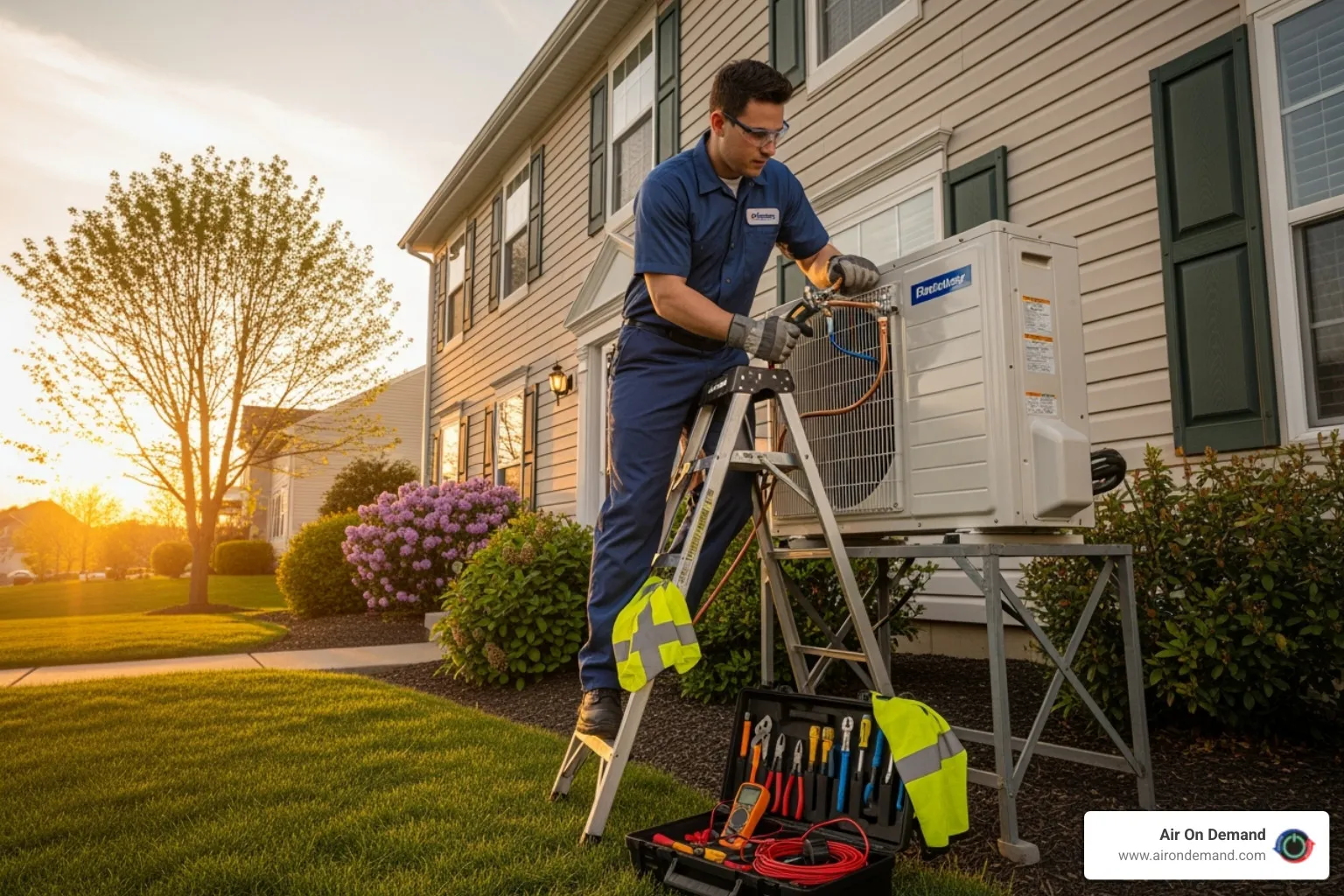Why Professional HVAC System Installation Matters
An HVAC system installation involves setting up the heating, ventilation, and air conditioning components that control your home's climate. This complex process includes installing furnaces or heat pumps, ductwork, cooling units, and integrating electrical and control systems.
Installation timelines vary:
- Simple AC replacement: 4-8 hours
- Full system installation: 3-5 days
This is not a DIY project. As one expert notes, "most average homeowners don't have the expertise needed to select, size and install one for themselves."
Proper installation is crucial for efficiency and longevity. A professionally installed system can save you up to 20% on energy costs and protects your investment by preserving manufacturer warranties. The process requires certified professionals who can handle regulated refrigerants, perform precise electrical work, and ensure compliance with local building codes.
Professional installation delivers the reliable comfort, energy efficiency, and peace of mind you expect from a new HVAC system.
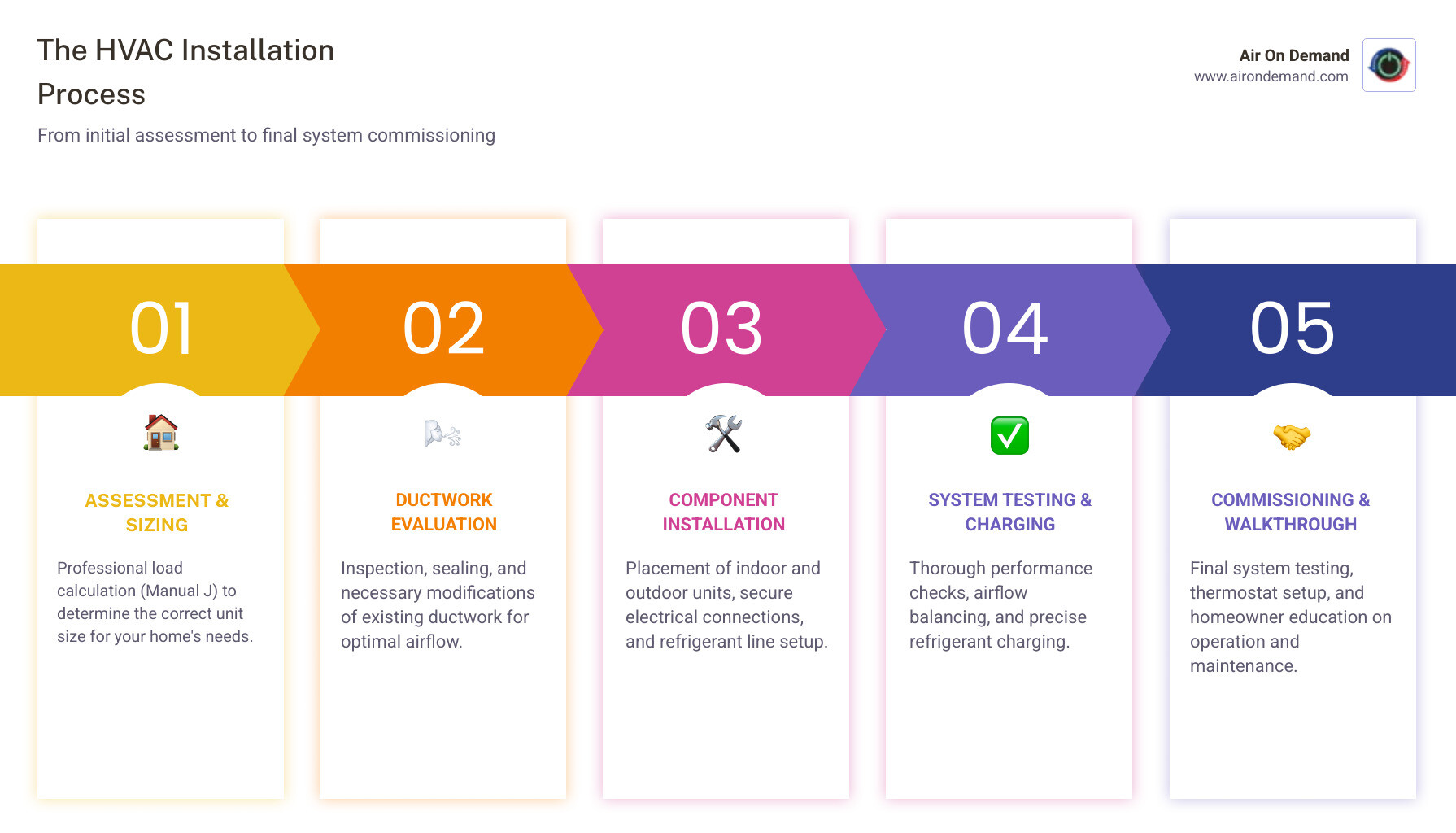
Pre-Installation: Planning for Success
This section covers everything a homeowner needs to decide and prepare for before the installation day arrives.
The planning phase is where you'll make key choices that affect your comfort and energy bills for years. Careful preparation helps avoid common mistakes that lead to poor performance and higher costs.
Types of HVAC Systems Available
Choosing the right HVAC system depends on your needs, budget, and home layout. Here are the three main types:
| System Type | Best Use Case | Efficiency | Cost | Key Benefits | Considerations |
|---|
| Central Air System | Whole-home cooling, often paired with a furnace for year-round climate control | Mid-to-high SEER2 ratings (up to 20% savings when replacing older models) | Moderate to high, depending on efficiency level | Consistent temperature throughout home, quiet indoor operation, excellent air filtration | Requires existing ductwork, less flexible for room-by-room control |
| Ductless Mini-Split System | Perfect for specific rooms, home additions, or houses without existing ducts | Very high SEER2 ratings (some models reach 28.5 SEER2) | Moderate to high per unit | Ultimate zone control, no ductwork needed, extremely efficient for targeted areas | Indoor units are visible on walls, higher cost for whole-home coverage |
| Heat Pump System | Ideal for both heating and cooling in moderate climates like South Florida | High SEER2 and HSPF ratings for maximum year-round efficiency | Similar to central AC, potentially higher for dual-fuel setups | Provides both heating and cooling, incredibly energy-efficient, can work with existing furnace | Less effective in extremely cold weather (though modern units perform much better) |
- Central air systems are ideal for homes with existing ductwork, providing consistent, whole-home cooling.
- Ductless mini-splits offer targeted climate control for specific rooms or additions, especially where ductwork is not feasible.
- Heat pumps are highly efficient for both heating and cooling, making them a cost-effective choice for year-round comfort in climates like Florida.
For a deeper dive, see our guide on Choosing the Right Air Conditioning Installation.
How to Determine the Correct HVAC Size
Sizing your HVAC system correctly is absolutely critical. HVAC "size" refers to its heating and cooling capacity (measured in BTUs). An undersized system will run constantly and wear out early, while an oversized system will cool too quickly, failing to remove humidity and creating a clammy environment.
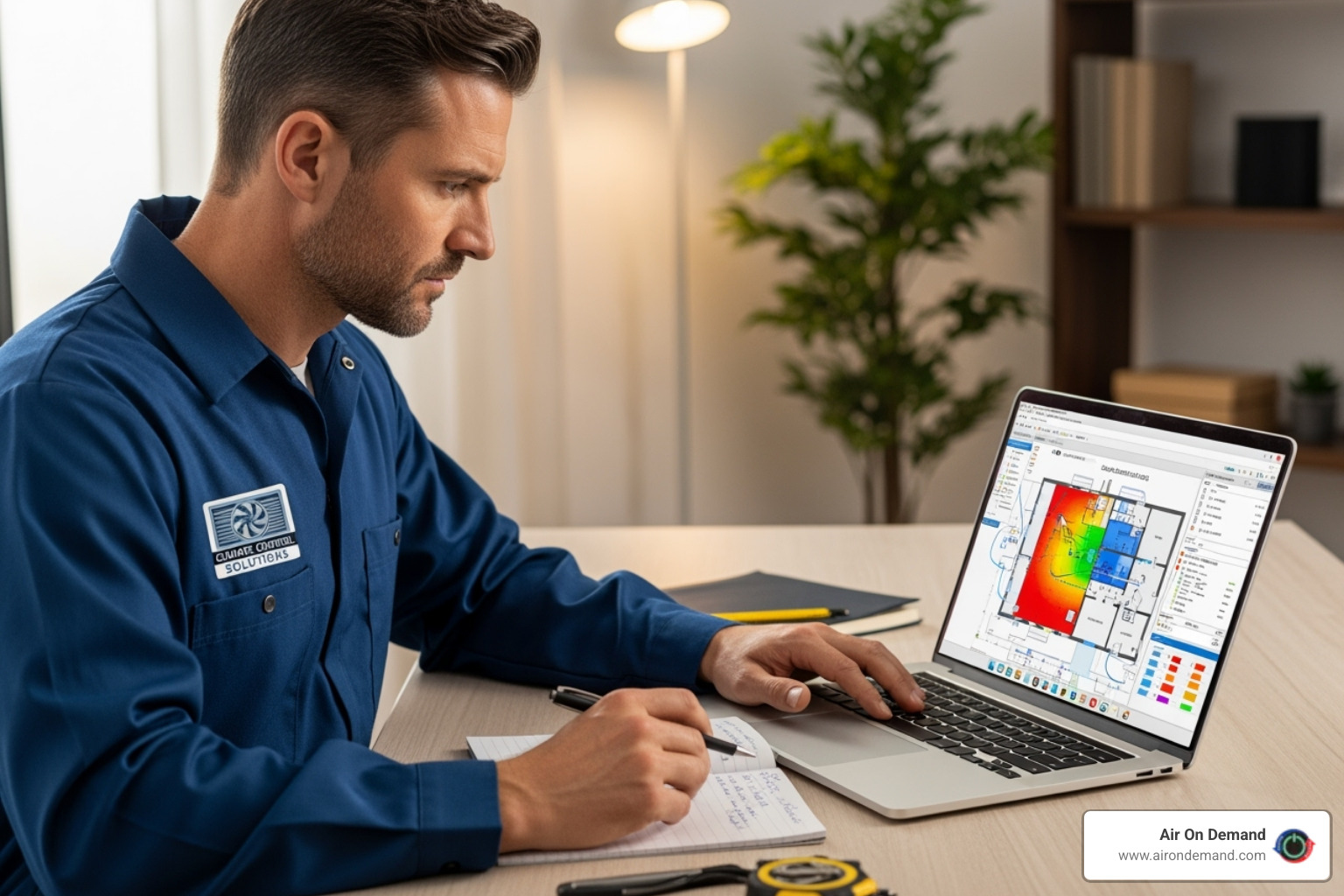
The correct method is a Manual J load calculation, a detailed analysis that considers factors like:
- Square footage and ceiling height
- Insulation levels
- Window types and placement
- Local climate zone
- Number of occupants and heat-generating appliances
This scientific approach ensures your new system provides optimal comfort and efficiency.
Key Factors for Your HVAC System Installation
Beyond type and size, consider these factors for your HVAC system installation:
- Energy Efficiency: Look for high SEER2 (cooling) and AFUE (heating) ratings. Upgrading a system over 10 years old can cut cooling costs by 20% or more.
- Home Comfort: Modern systems with variable-speed technology offer superior humidity control, consistent temperatures, and quieter operation.
- Budget: Balance upfront costs with long-term savings from energy efficiency, fewer repairs, and potential rebates.
- Future Needs: Consider plans for home additions or smart home integration to avoid costly modifications later.
For more ideas, read about Upgrades to Consider with Air Conditioning Installation.
Finding and Choosing a Qualified HVAC Contractor
This is the most important decision in the process. The best equipment will underperform if installed incorrectly.
When choosing a contractor, verify they have:
- Proper Licensing and Insurance: Ensure they hold state licenses and carry both liability and worker's compensation insurance.
- Industry Certifications: EPA certification for refrigerant handling is mandatory. Additional certifications show a commitment to quality.
- A Strong Reputation: Check online reviews and ask for recent customer references.
- Detailed Quotes: Get multiple itemized quotes to compare the scope of work, equipment, and warranties. The lowest bid isn't always the best value.
Ask about their experience, installation process, and how they handle post-installation issues. For extra assurance, you can find an accredited contractor via the ACCA.
The Professional HVAC System Installation Process
A step-by-step look at what homeowners can expect during a professional installation, from start to finish.
Once you've selected your system, the HVAC system installation begins. A professional team turns your chosen equipment into a fully functional climate control system, ensuring a seamless process from start to finish.
What a Professional Service Includes
A professional HVAC system installation is a comprehensive process designed for safety, efficiency, and long-term performance.
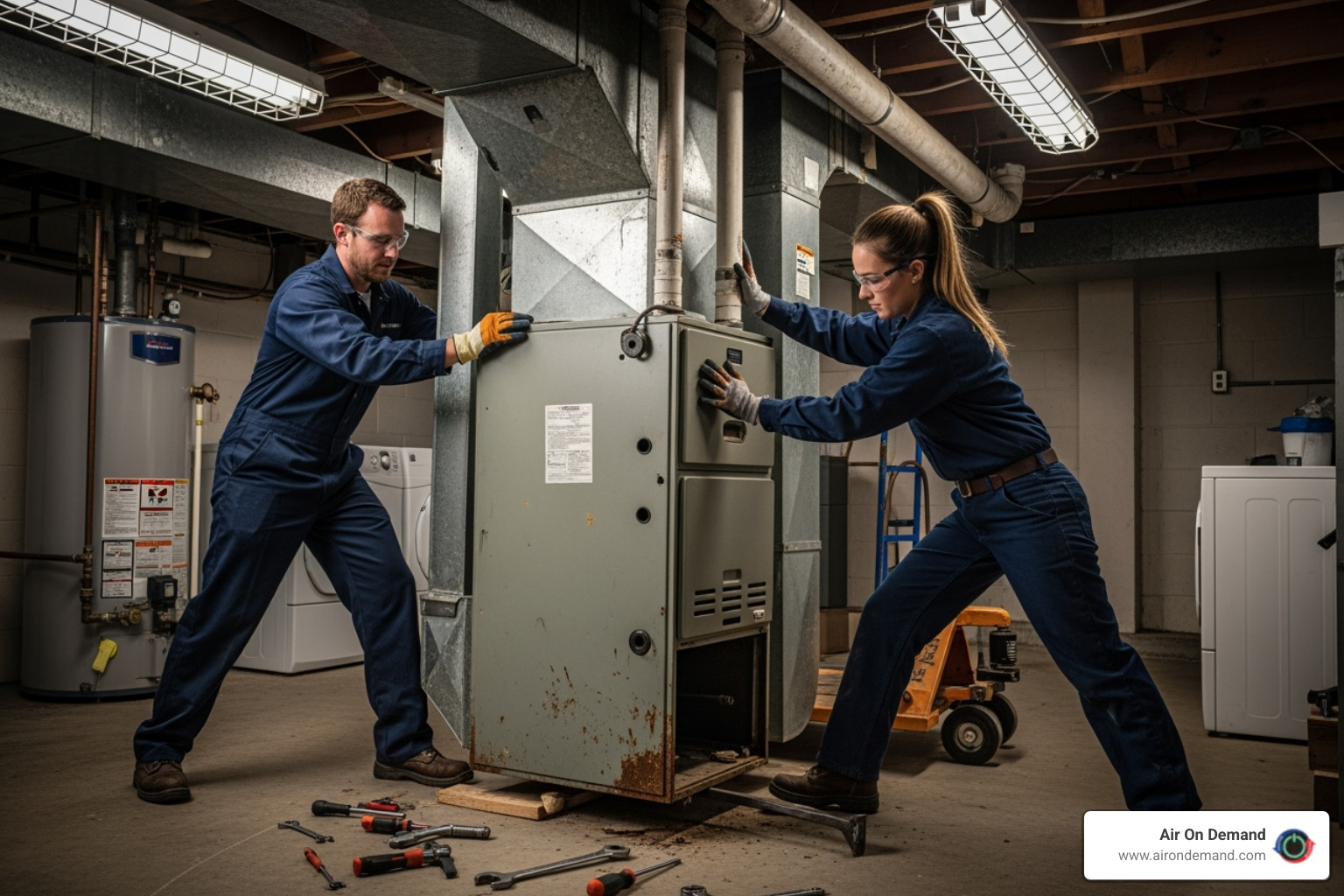
Key steps include:
- Old System Removal: Technicians safely disconnect and remove old equipment, properly disposing of refrigerants according to EPA regulations.
- Site Preparation: Your home is protected by covering floors and furniture, and the work area is prepared to meet safety codes.
- Equipment Placement: The new indoor and outdoor units are positioned for optimal performance, easy maintenance, and quiet operation, following manufacturer and code requirements.
- Electrical Connections: Certified technicians connect all wiring, ensuring the system has the correct voltage to operate safely.
- Refrigerant Line Installation: Copper lines are installed and pressure-tested to connect the indoor and outdoor units, preventing leaks.
- Ductwork Connection: The new unit is connected to your duct system with all connections properly sealed to prevent energy loss.
- System Testing and Commissioning: The entire system is thoroughly tested for airflow, refrigerant levels, and overall performance to ensure it operates at peak efficiency.
- Final Walkthrough: The team explains your new system's operation, thermostat controls, and maintenance tips.
The Critical Role of Ductwork
Your ductwork is the circulatory system for your HVAC. Even the best unit will underperform if ducts are leaky, undersized, or poorly installed.
During an HVAC system installation, we perform a thorough ductwork inspection to identify leaks, blockages, or sizing issues. Leaky ducts can waste up to 30% of your conditioned air.
- Sealing leaks is a cost-effective way to improve efficiency.
- Duct modifications may be needed to improve airflow and accommodate the new system.
- Proper airflow is essential for efficiency, comfort, and equipment longevity.
Properly sealed and sized ductwork is crucial for energy efficiency. This is a key part of The Importance of Proper AC Installation.
Installation Timeline and What to Expect
While every HVAC system installation is unique, here are some general timelines:
- AC-Only Replacement: Typically completed in 4-8 hours.
- Complete System Installation: Usually takes 3-5 days.
Factors that can influence the timeline include:
- System Complexity: A simple replacement is faster than installing a new type of system or adding features like zoning.
- Ductwork Changes: Extensive modifications or new ductwork installation can add several days to the project.
- Permits and Inspections: We handle all paperwork, but the inspection schedule can affect the timeline.
- Accessibility: Tight attics or crawl spaces can slow down the process.
We provide a clear timeline estimate during your consultation, prioritizing quality and safety over speed.
Common Installation Mistakes to Avoid
Small mistakes during an HVAC system installation can lead to major problems. This is why professional installation is so critical.
Common pitfalls include:
- Incorrect Unit Sizing: An oversized unit short-cycles, wasting energy and failing to control humidity. An undersized unit runs constantly and wears out prematurely.
- Improper Thermostat Placement: Placing a thermostat in a draft or direct sunlight leads to inaccurate readings and inefficient operation.
- Poor Airflow Design: Leaky or undersized ducts create hot and cold spots and force the system to work harder.
- Refrigerant Leaks: Improper connections can cause leaks that reduce cooling capacity and harm the environment.
- Bad Wiring: Incorrect electrical work is a safety hazard and can damage system components.
DIY installation is risky. It can void warranties, lead to safety hazards, and result in poor performance. An HVAC system installation requires specialized tools and certifications. Learn more about ensuring a smooth process with our guide on 3 Steps to Ensure a Successful Heating Installation.
Post-Installation: Costs, Warranties, and Long-Term Care
This section details the financial aspects and ongoing responsibilities after the new system is in place.
Your HVAC system installation is complete, but our commitment doesn't end there. Understanding the costs, warranties, and maintenance is key to maximizing your investment for years to come.
Understanding HVAC System Installation Costs
Several factors influence the final cost of an HVAC system installation. A typical central air installation can range from $2,900 to $9,000, depending on:
- Unit Size and Type: A larger, more powerful system for a big home costs more than a smaller unit.
- Energy Efficiency: High-efficiency models with better SEER2 ratings have a higher upfront cost but provide long-term savings.
- Labor Fees: This reflects the time and expertise required for a safe and precise installation.
- Ductwork Modifications: Major repairs or replacement can add significantly to the cost.
- Removal and Disposal Fees: Proper disposal of the old unit typically adds a small fee.
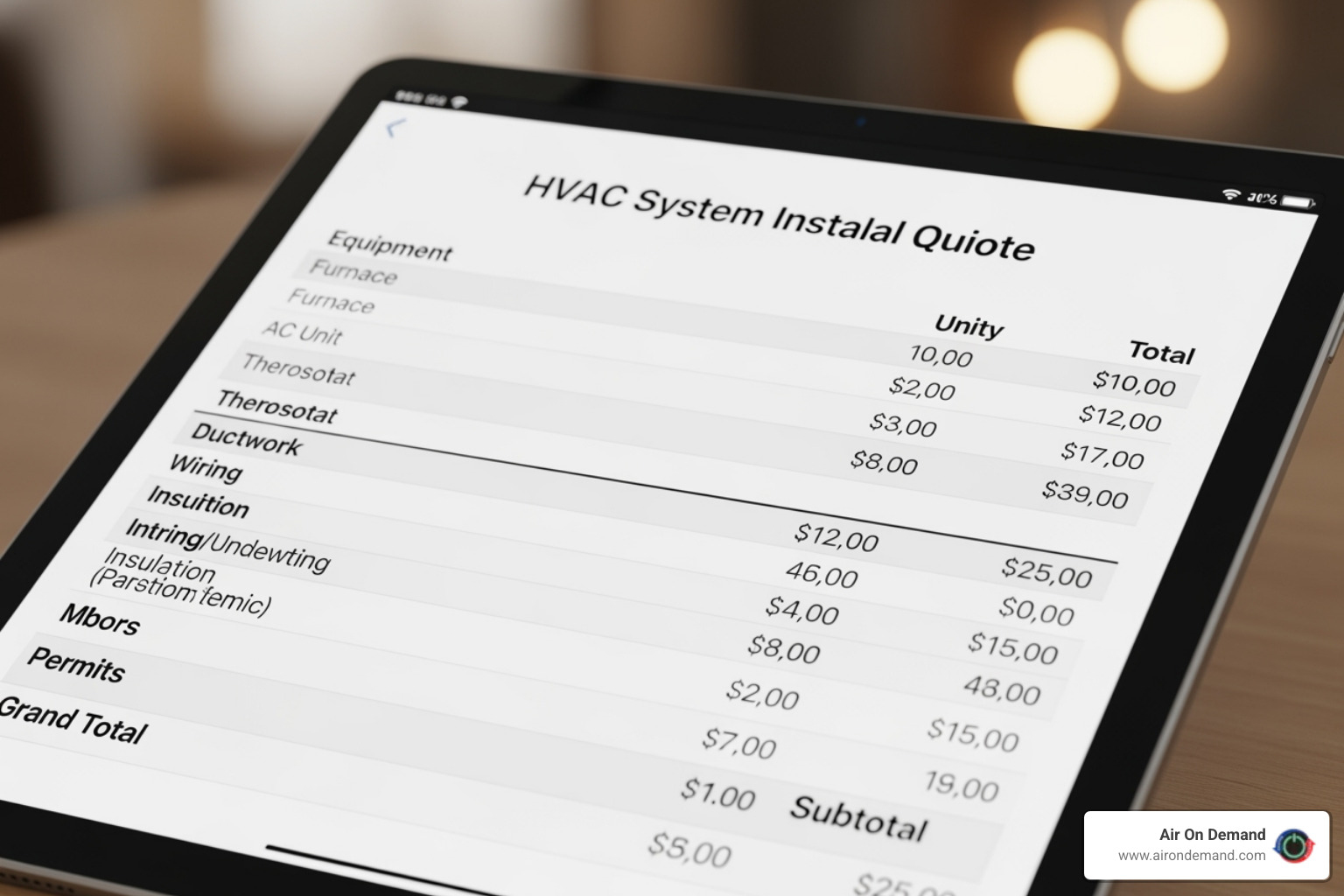
We provide a detailed, itemized quote so you know exactly what you're paying for. For more industry insights, you can review resources like the Forbes Home cost guide.
Warranties and Government Incentives
Your new HVAC system installation comes with valuable protections.
- Manufacturer Parts Warranty: As a Daikin partner, we offer an industry-leading 12-year parts warranty when you register your new system within 90 days.
- Labor Warranty: We stand behind our workmanship, covering any issues that arise from the installation.
- Daikin Comfort Promise: If you're not fully satisfied with your Daikin system in the first year, we will resolve the issue or remove the equipment and provide a full refund.
Additionally, you may be eligible for federal tax credits and local utility rebates for installing high-efficiency equipment. We help you identify these opportunities to maximize your savings. The ENERGY STAR Rebate Finder is another great resource.
Recommended Post-Installation Maintenance
Proper care ensures your new HVAC system installation performs efficiently for its entire lifespan (15-20 years for furnaces, 10-15 for ACs).
- Change Filters Regularly: Check filters monthly and replace them every 1-3 months to maintain airflow and air quality.
- Schedule Annual Tune-Ups: Professional maintenance before each heating and cooling season catches small problems before they become major repairs.
- Keep the Outdoor Unit Clear: Remove leaves, debris, and overgrown shrubs from around the unit to ensure proper airflow.
- Replace Thermostat Batteries: If applicable, replace batteries annually to prevent system disruptions.
We offer comprehensive maintenance plans to take the guesswork out of system care. Learn more about our services for HVAC Installation in Miami, FL.
Frequently Asked Questions about HVAC Installation
An HVAC system installation is a major investment, and it's normal to have questions. Here are answers to some of the most common ones we receive.
What are the signs my HVAC system needs to be replaced?
Look for these common indicators that it's time for a new system:
- Age: If your AC is over 10-15 years old or your furnace is over 15-20, it's likely losing efficiency.
- Frequent Breakdowns: If repair calls are becoming routine, a replacement is often more cost-effective.
- Rising Energy Bills: Unexplained increases in your utility bills suggest the system is working harder to do its job.
- Strange Noises or Smells: Grinding, squealing, or musty odors can signal serious internal problems.
- Uneven Temperatures: Hot and cold spots indicate the system can no longer distribute air effectively.
- Poor Indoor Air Quality: Increased dust or humidity issues can mean your system is failing.
How does a new HVAC system improve energy efficiency?
A new HVAC system installation boosts efficiency in several ways:
- Higher Efficiency Ratings: Modern systems have much higher SEER2 (cooling) and AFUE (heating) ratings, meaning they convert more fuel or electricity into comfort.
- Advanced Technology: Features like variable-speed motors allow the system to run at lower, more efficient speeds, saving energy and improving comfort.
- Smart Thermostat Compatibility: Pairing a new system with a smart thermostat can optimize performance and reduce heating and cooling costs by up to 20%.
- Proper Sizing: A professional installation ensures the unit is correctly sized for your home, eliminating the waste associated with oversized or undersized systems.
Can I install an HVAC system myself?
We strongly advise against DIY HVAC system installation. It's a complex job that requires professional expertise for several reasons:
- Specialized Knowledge and Tools: Installation requires equipment and skills that most homeowners do not possess, including handling high-voltage electricity and regulated refrigerants.
- Safety Risks: Improper installation can lead to electrical shock, refrigerant leaks, or even fire hazards like carbon monoxide leaks.
- Warranty Protection: Most manufacturer warranties, including Daikin's 12-year parts warranty, are voided by DIY installation.
- Performance and Efficiency: Without proper sizing and commissioning, the system will not operate efficiently, leading to higher bills and a shorter lifespan.
- Building Codes: Professionals ensure the installation meets all local codes and passes required inspections.
Conclusion
You now have a roadmap for your HVAC system installation, from planning and selection to understanding the importance of professional work. A new system is more than just equipment; it's an investment in your home's comfort, health, and efficiency.
Professional installation is the key to open uping the full benefits of your new system. The complexity of modern HVAC equipment demands the expertise of trained technicians to ensure safety, peak performance, and warranty protection.
The rewards are significant: improved comfort with consistent temperatures, substantial energy savings, and increased home value. Most importantly, you gain the peace of mind that comes from a reliable system installed correctly.
In South Florida and Arizona, a high-performing HVAC system is essential. At Air On Demand, our partnership with Daikin allows us to offer industry-leading equipment backed by a 12-year parts warranty and the Daikin Comfort Promise. We combine this with transparent service and convenient online booking to make your HVAC system installation a smooth and stress-free experience.
Ready to upgrade your home's comfort? Don't wait for a system failure. Schedule Your AC Service in Miami, FL today and let our certified professionals guide you through the process.

